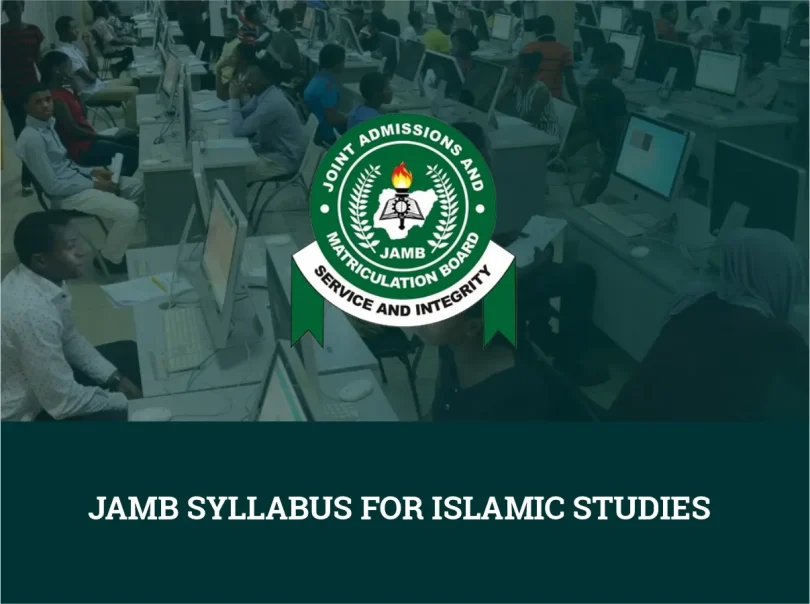The Joint Admissions and Matriculation Board (JAMB) has released the official syllabus for Islamic Studies to guide candidates preparing for the UTME examination. The JAMB Syllabus for Islamic Studies highlights the important topics and themes students need to study to succeed.
Its purpose is to help candidates focus their revision on key areas such as the life of the Prophet Muhammad (SAW), the Holy Qur’an, Islamic beliefs, history, and practices. By following this syllabus, students can prepare effectively and increase their chances of performing well in the Islamic Studies exam.
If you have not yet accessed the JAMB Syllabus for Islamic Studies, read this post carefully to see the full syllabus and a list of recommended reading materials that will help ensure you pass.
JAMB Syllabus For Islamic Studies
| PART | TOPICS / CONTENTS / NOTES |
|---|---|
| PART 1: THE QUR’AN AND HADITH | |
| 1. | Revelation of the Glorious Qur’an |
| (i) Visits of the Prophet (SAW) to Cave Hira | |
| (ii) His reaction to the first revelation and its importance | |
| (iii) Different modes of revelation (Q.42:51): inspiration behind the veil, through an angel, etc. | |
| (iv) Piecemeal revelation (Q.17:106) (Q.25:32) | |
| 1b. | Preservation of the Glorious Qur’an |
| (i) Complete arrangement | |
| (ii) Differences between Makkah and Madinan suwar | |
| (iii) Recording, compilation and standardization of the Glorious Qur’an | |
| (iv) The role played by the Companions of the Prophet (SAW) | |
| 1c. | Importance of the Glorious Qur’an as a source of guidance in spiritual, moral, economic, political and socio-cultural matters. |
| 1d. | Proof of the Divine authenticity of the Glorious Qur’an (Q.4:82) (Q.41:42) |
| (i) Uniqueness of the Glorious Qur’an (Q.39:27) (Q.17:88) (Q.75:16-19) | |
| (ii) Divine preservation of the Glorious Qur’an (Q.15:9) | |
| 2. | Tafsir |
| (i) Historical development of Tafsir | |
| (ii) Importance of Tafsir | |
| (iii) Types of Tafsir | |
| 3. | Introduction to Tajwid (Theory and Practice) |
| 4. | Study of the Arabic text of the following suwar/ayats with tajwid |
| (a) al-Fatihah (Q.1) | |
| (b) al-Adiyat (Q.100) | |
| (c) al-Qari’ah (Q.101) | |
| (d) at-Takathur (Q.102) | |
| (e) al-Asr (Q.103) | |
| (f) al-Humazah (Q.104) | |
| (g) al-Maun (Q.107) | |
| (h) al-Kawthar (Q.108) | |
| (i) al-Kafirun (Q.109) | |
| (j) al-Nasr (Q.110) | |
| (k) al-Masad (Q.111) | |
| (l) al-Ikhlas (Q.112) | |
| (m) al-Falaq (Q.113) | |
| (n) an-Nas (Q.114) | |
| 5. | Study of the Arabic text of the following suwar/ayats with tajwid |
| (a) al-A’ala (Q.87) | |
| (b) ad-Duha (Q.93) | |
| (c) al-Inshirah (Q.94) | |
| (d) at-Tin (Q.95) | |
| (e) al-Alaq (Q.96) | |
| (f) al-Qadr (Q.97) | |
| (g) al-Bayyinah (Q.98) | |
| (h) al-Zilzal (Q.99) | |
| (i) Ayatul-Kursiy (Q.2:255) | |
| (j) Amanar-Rasul (Q.2:285-6) | |
| (k) Laqad jaakun (Q.9:128-129) | |
| 6. | Hadith |
| (a) History of Hadith literature – Collection of Hadith from the time of the Prophet (SAW) to the period of the six authentic collectors of Hadith | |
| (b) Authentication of Hadith | |
| (i) Isnad (Asma’ur-rijal) | |
| (ii) Matn | |
| (iii) Classification of Hadith into Sahih, Hassan and Da’if | |
| (c) The relationship between Hadith and the Glorious Qur’an | |
| (i) The importance of Hadith | |
| (ii) The similarities and differences between Hadith and the Glorious Qur’an | |
| (d) The six sound collectors of Hadith – biographies and their works | |
| (e) Muwatta and its author – The biography of Imam Malik and the study of his book | |
| (f) The study of the Arabic texts of selected ahadith from an-Nawawi’s collection (numbers listed in original text) | |
| 7. | Moral lessons in the Glorious Qur’an and Hadith |
| (a) General moral lessons from Sage Luqman’s admonition to his son (Q.31:18-20) | |
| (b) Goodness to parents (Q.17:23-24) | |
| (c) Honesty (Q.2:42) (Q.61:2-3) | |
| (d) Prohibition of bribery and corruption (Q:2:188), alcohol and gambling (Q.2:219) (Q.5:93-94), stealing and fraud (Q.5:41) (83:1-5), smoking, drug abuse, and intoxicants (various verses) | |
| (e) Dignity of labour (Q.62:10) (Q.78:11); Hadith from Bukhari and Ibn Majah | |
| (f) Behaviour and modesty in dressing (Q.24:27-31) (Q.33:59) | |
| (g) Adultery and fornication (Q.17:32) (Q.24:2), homosexuality (Q.11:77-78), obscenity (Q:4:14-15); Hadith on privacy | |
| (h) Leadership (Q.2:124) and justice (Q.4:58, 135) (Q.5:9); Hadith about governance | |
| (i) Trust and obligations (Q:4:58) (Q.5:1) and promises (Q.16:91); Hadith on faithfulness to promises | |
| (j) Piety (Taqwa) (Q:2:177) (Q.3:102) (Q.49:13); Hadith 18 and 35 of an-Nawawi | |
| (k) Tolerance, perseverance and patience (Q.2:153-157) (Q.3:200) (Q.103:3); Hadith 16 of an-Nawawi | |
| (l) Unity and brotherhood (Q.3:103) (Q.8:46) (Q.49:10); Hadith 35 of an-Nawawi | |
| (m) Enjoining what is good and forbidding what is wrong (Q.3:104, 110) (Q.16:90); Hadith 25 and 34 of an-Nawawi | |
| PART II: TAWHID AND FIQH | |
| 8. | Faith |
| (a) | Tawhid: Its importance and lessons |
| (b) | Kalimatush-Shahadah |
| (i) Its meaning and importance | |
| (ii) The Oneness of Allah as contained in the following verses: (Q.3:19) (Q.2:255) (Q.112:1-4) | |
| (iii) The servanthood and messengership of the Prophet Muhammad (SAW) as contained in verses (Q.3:144) (Q.18:110) (Q.48:29) (Q.34:28) | |
| (iv) Universality of his message (Q.7:158) (Q.34:28) | |
| (v) Finality of his Prophethood (Q.33:40) | |
| (c) | Shirk |
| (i) Beliefs incompatible with Tawhid: Worship of idols, ancestral worship, trinity, atheism (verses referenced) | |
| (ii) Sins considered shirk (Q.4:48,116) | |
| (d) | Angels |
| (i) Their nature and duties | |
| (ii) Their importance in religion and belief | |
| (e) | Holy Books |
| (i) Names and importance of the scriptures | |
| (ii) The Qur’an as the final revelation | |
| (f) | Prophets and Messengers |
| (i) The difference between a prophet and messenger | |
| (ii) The major prophets and messengers | |
| (g) | Life after Death |
| (i) The reality of life after death | |
| (ii) Barzakh | |
| (iii) The Day of Judgement | |
| 9. | Islamic Jurisprudence (Fiqh) |
| (a) | Sources of Islamic law |
| (i) The Qur’an | |
| (ii) Hadith | |
| (iii) Ijma (consensus) | |
| (iv) Qiyas (analogy) | |
| (b) | Pillars of Islam |
| (i) Shahadah | |
| (ii) Salah | |
| (iii) Zakah | |
| (iv) Sawm | |
| (v) Hajj | |
| (c) | Purification |
| (i) Types of purification | |
| (ii) Methods of purification | |
| (d) | Salah |
| (i) Times of prayers | |
| (ii) Conditions of prayers | |
| (iii) Sunnah prayers | |
| (iv) Friday prayer | |
| (e) | Zakah |
| (i) Meaning and importance | |
| (ii) Types of Zakah | |
| (iii) Conditions for Zakah | |
| (f) | Sawm |
| (i) Fasting during Ramadan | |
| (ii) Conditions and rulings | |
| (g) | Hajj |
| (i) The rituals of Hajj | |
| (ii) Conditions and significance |
Recommended Texts For Islamic Studies
- Abdul, M. O. A. (1976). Studies in Islam Series Book 3. Lagos: IPB.
- Abdul, M. O. A. (1982). Studies in Islam Series Book 2. Lagos: IPB.
- Abdul, M. O. A. (1988). The Classical Caliphate. Lagos: IPB.
- Abdulrahman, & Canham. (n.d.). The Ink of the Scholar. Oxford University Press.
- Ali, A. Y. (1975). The Holy Qur’an Text: Translation and Commentary. Leicester: The Islamic Foundation.
- Ali, M. M. (n.d.). The Religion of Islam. Lahore.
- Doi, A. R. I. (1997). Shariah: The Islamic Law. Kuala Lumpur: Noordeen.
- Hay Lal, M. (1982). The Life of Muhammad (SAW). Academic Press.
- Lemu, A. (1992). Methodology of Primary Islamic Studies. Lagos: IPB.
- Lemu, A. (1993). Islamic Studies for SSS, Book 1. Lagos: IPB.
- Lemu, A. (1993). Islamic Studies for SSS, Books. Minna: IET.
- Muhammad, S. Q. (2010). al-Burhanu fi tajwidil Qur’an. Cairo: Shirkatul-Qudus.
- Opeloye, M. O. (1996). A Dictionary of Peoples and Places in the Qur’an. Lagos: Academic Press.
- Philips, A. A. B. (1997). Usool at-Tafseer. Kuala Lumpur: Noordeen.
- Quadri, Y. A., et al. (1990). Al-Iziyyah for the English Audience. Ijebu Ode: Shebiotiuom Publication.
- Rahim, A. (1992). Islamic History. Lagos: IPB.
- Sambo, M. B., et al. (1984). Islamic Religious Knowledge for WASC Book 1. Lagos: IPB.
- Sambo, M. B., et al. (1984). Islamic Religious Knowledge for WASC Book 3. Lagos: IPB.
- Trimingham, J. S. (1993). A History of Islam in West Africa. Oxford: Oxford University Press.
Make sure to follow the syllabus carefully and use the recommended texts along with past questions to guide your study. This approach will help you get the best results in your Islamic Studies exam.
If you have any questions, feel free to ask in the comments, and we will get back to you shortly. Don’t forget to share this post with your friends who are also preparing for JAMB. You can also visit our page to find syllabi for other JAMB subjects. Good luck with your studies!







Leave a Comment